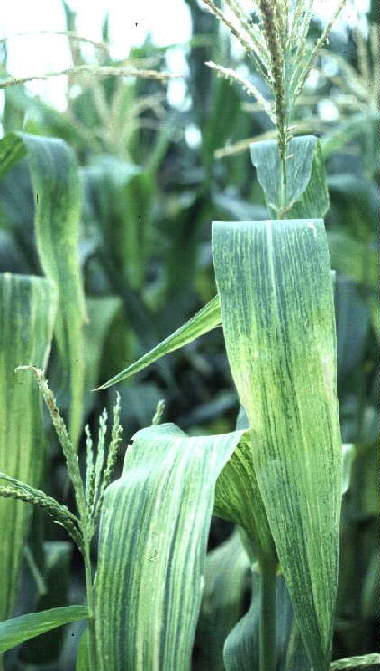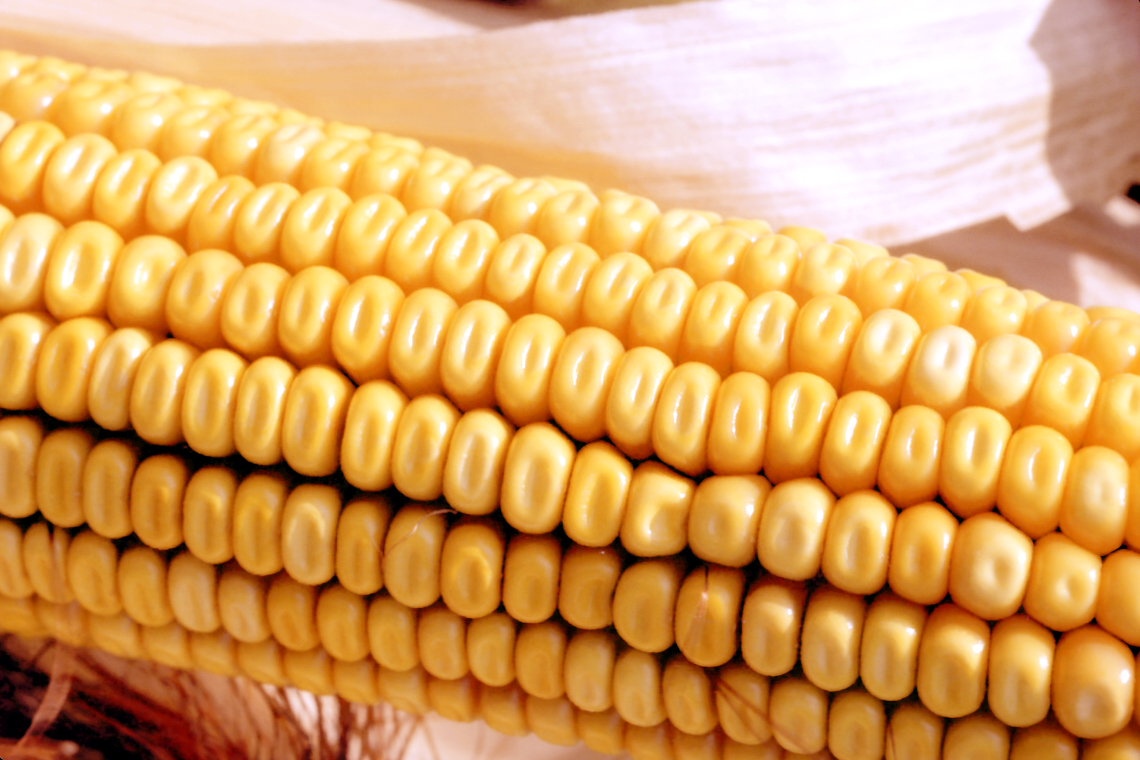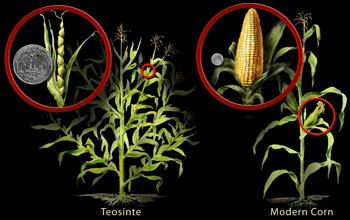
Pollination of Zea mays
 Zea mays is monoecious, which means that it bears its male organs (stamens) and
its female organs (pistils) on separate flowers but on the same plant.
The male flowers make up the tassel. They grow in clusters and each male
flower contains three baglike structures called anthers that produce
pollen. An anther can contain up to 2,500 pollen grains.
The pollen is wind-dessimated. The female flowers are found in pairs on
an unfertilized ear of corn. Only one flower of the pair matures and is
able to reproduce. Each flower extends a long, threadlike ovary and at
blossoming time silks extend from the husk. The silk is covered with
fine hairs that are designed to capture pollen. When corn is at its maximum height,
the anthers split open and let out their pollen. This usually lasts five
to eight days. It is a naturally cross-fertilized plant because the pollen
produced by one plant does not often fertilize that same plant. The pollen grains are often germinated on the style and
open up the pollen tubes which penetrate the tissues of the silk. The
pollen tubes then reach the micropyles on the ovaries about fifteen to
twenty-five hours after pollination.
Zea mays is monoecious, which means that it bears its male organs (stamens) and
its female organs (pistils) on separate flowers but on the same plant.
The male flowers make up the tassel. They grow in clusters and each male
flower contains three baglike structures called anthers that produce
pollen. An anther can contain up to 2,500 pollen grains.
The pollen is wind-dessimated. The female flowers are found in pairs on
an unfertilized ear of corn. Only one flower of the pair matures and is
able to reproduce. Each flower extends a long, threadlike ovary and at
blossoming time silks extend from the husk. The silk is covered with
fine hairs that are designed to capture pollen. When corn is at its maximum height,
the anthers split open and let out their pollen. This usually lasts five
to eight days. It is a naturally cross-fertilized plant because the pollen
produced by one plant does not often fertilize that same plant. The pollen grains are often germinated on the style and
open up the pollen tubes which penetrate the tissues of the silk. The
pollen tubes then reach the micropyles on the ovaries about fifteen to
twenty-five hours after pollination.
Fertilization of Zea mays
As the
pollen grain moves down
through the tissues of the silk, it has carbohydrates that
contain nourishment for
its growth. They carry with them their own
nucleus, as well as, two other nuclei (sperm). The ovary is then reached
and the pollen tube enters the micropyle. The end of the tube
ruptures causing the sperms to be released. One sperm fuses with a
female egg nucleus producing an embryo, the other fuses with a double
nucleus to produce endosperm. Endosperm provides food storage which will
nourish the embryo when the seed germinates. Some of the structures
mentioned in this portion are explained more in depth in the
Adaptation portion of this website.
nourishment for
its growth. They carry with them their own
nucleus, as well as, two other nuclei (sperm). The ovary is then reached
and the pollen tube enters the micropyle. The end of the tube
ruptures causing the sperms to be released. One sperm fuses with a
female egg nucleus producing an embryo, the other fuses with a double
nucleus to produce endosperm. Endosperm provides food storage which will
nourish the embryo when the seed germinates. Some of the structures
mentioned in this portion are explained more in depth in the
Adaptation portion of this website.
Origin of Zea mays
Zea mays
originated from teosinte more than 6,000 years ago. Scientist believe that teosinte was one of the parents of a hybrid from which Zea mays developed. It
originated from a cross between teosinte and a now extinct closely
related grass or is a cross between wild teosinte and a cultivated form
of teosinte. Scientists believe that Native American farmers somehow
transformed the teosinte ear of corn to the modern Zea mays ear
of corn. The oldest known fossil of corn measures only one inch long and
only has about ten kernels on it.
Corn can no longer survive in the wild because of
its evolvement from teosinte. It requires human cultivation to grow, if
we became extinct Zea mays would cease to exist. It is also the
only plant in the family Poaceae (grass family), that is monoecious. Zea mays has an unbranched stalk
and a lower number of ears per plant but the ears can grow bigger. The
kernel of teosinte was originally encased in a hard shell, but is no
longer encased in that shell.
Teosinte still grows wild in Mexico's western Sierra Madre.
one of the parents of a hybrid from which Zea mays developed. It
originated from a cross between teosinte and a now extinct closely
related grass or is a cross between wild teosinte and a cultivated form
of teosinte. Scientists believe that Native American farmers somehow
transformed the teosinte ear of corn to the modern Zea mays ear
of corn. The oldest known fossil of corn measures only one inch long and
only has about ten kernels on it.
Corn can no longer survive in the wild because of
its evolvement from teosinte. It requires human cultivation to grow, if
we became extinct Zea mays would cease to exist. It is also the
only plant in the family Poaceae (grass family), that is monoecious. Zea mays has an unbranched stalk
and a lower number of ears per plant but the ears can grow bigger. The
kernel of teosinte was originally encased in a hard shell, but is no
longer encased in that shell.
Teosinte still grows wild in Mexico's western Sierra Madre.
Corn Hybrids
George H. Shull, during the early 1900's, began performing experiments that tried to produced high-yielding corn plants. He produced pure hereditary lines of corn by inbreeding the same variety and then crossed the inbred lines. These were called single-cross hybrids and produced low hybrid seed yields. In 1918, Donald F. Jones created the double-cross hybrid by crossing two single-cross hybrids. These hybrids lowered production costs because the female parent produced enough seeds, so hybrids became commercially important. By the 1920's double-cross hybrids were being sold commercially. By the 1990's scientists were developing corn that was genetically modified to resist diseases and pests.